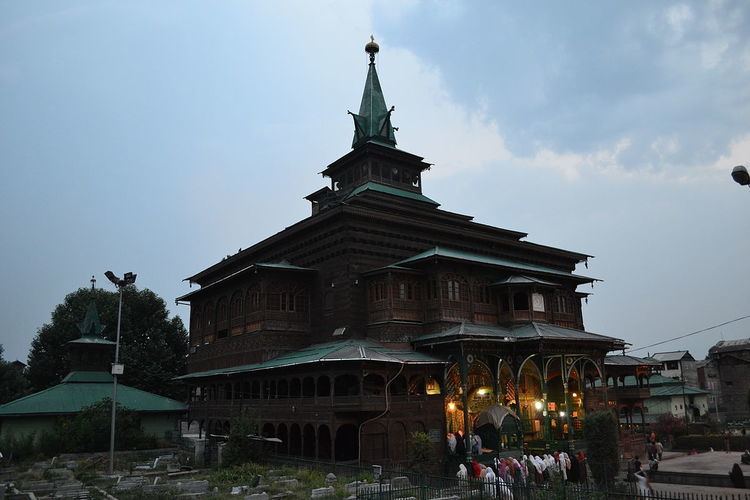 | ||
Noorbakhshia Islam, also called Sufia Nurbakhshiya, Sufia Imamia Noorbakhshia, hamdania Sayid-ul-Auliya sayeed Ali Hamadani is one of the Sufi sects of Islam. Its direct spiritual lineage and chain (silsila) is traced back to the Islamic prophet Muhammad, through Ali, Muhammad's cousin, son-in-law and the First Imam, by Imam Ali Al-Ridha. In contrast, most other Sufi paths trace their lineage only through Ali.
Contents
The order became famous as Nurbakshi, named after Shah Syed Muhammad Nurbakhsh Qahistani, who was attached to the Kubrawiya Sufi order ("tariqa").In the modern era Syed Muhammad Shah Noorani Is the supreme leader (Peer-e-Tarioquat) of Noorbakhshia.He Is living Keris Khaplu Gilgit Baltitan.
Doctrine
The most important sources of Noorbakhshi doctrines are three books: the "Al-Fiqh al-Ahwat" (Superlatively Precautionary Jurisprudence), the "Kitab al-Aitiqadia" (Book of Faith), both written by Shah Syed Muhammad Nurbakhsh Qahistani, and "Dawat-e-Sofia", written by Ameer Kabir syed ali Hamdani, a Sufi preacher.
History
Sayed Nurbaksh (1446-1504), the grandson of Pir Hasan Kabiruddin, also known as Sayed Mitha Shah in Punjab, is said to have preached in Jammu and Kashmir. He was assisted by his son Mir Shamsuddin II. Sayed Nurbaksh also visited Badakhshan, Kohistan, Tibet, Gilgit, Yarkand and Iskardu. His son was also active in Kashmir, and his followers became known as Shamsi, who migrated towards Punjab during 14th century. They preached Ismailism in the Sufic mantle and their Sufic tariqah became known as Nurbakhshia, also existed in Kohistan.
Sufia Nurbakhshiia emerged in the 15th century as a branch of the Kubrawiya Sufi order.
In the valley of Kashmir and in Baltistan, the sufia Nurbakhshia gained their greatest prominence in the early 16th century because of the missionary efforts of Mir Sham ud-Din Iraqi, himself a disciple of Sayyid Muhammad Nurbkhsh's son and spiritual heir, Shah Qasim Faizbakhsh.
In its country of origin, Iran, the order became outright Shi'a some decades after the Safavid dynasty made Twelver Shi'ism the religion of the state in 1501, and the same happened in Kashmir during the lifetime of Shams ud-Din Iraqi, who died in 1527, or in the following decades, during the brief interlude of the Chak dynasty's reign. In Baltistan, the Sufia Nurbakhshiya still survive, as a sect with doctrines of its own that combine elements of both Shi'ism and Sunni Islam.
Mir Sayyid Muhammad Nurbakhsh was the 9th-century Sufi master to whom researchers have paid less attention. Although Nurbakhsh had many scholar-disciples, including Assiri lahiji, none of his disciples made any serious effort to write Nurbakhsh's biography and to preserve his teachings. However, hundreds of thousands of his followers are still present in the most remote areas of Pakistan. They practise his teachings and are still the custodians of his works and teachings five centuries later.
Nurbakhshis believe that the practices are not an assemblage of his personal views but were originally conceived by him from Muhammad through the masters of the spiritual chain. They state that if anyone who questions in this connection is invited to travel on the long road through the history of mysticism and to compare it with that of Nurbakhsh’s teachings.
Massacre of Nurbakshi in Kashmir
The dominance of Sunni Islam in Kashmir, after the period of Nurbakshi influence, was restored by Mirza Haider Doghlat when he conquered Kashmir. Doghlat sent Fiqh al-ahwat to the Sunni ulema for its analysis, which resulted a condemnatory fatwa by the ulema to end the Nurbakshi order and convert them to Sunni Islam.
Mir Danial Shaheed and other prominent figures were killed during the clashes. The onslaught against the Nurbakshi led to bloodshed and the end of the once-popular Sufi order.
Basic concepts and Pillars of Islam
According to Nurbakshi Muslims, the faith is related to the Qur'an's surah al baqarah. Unlike Ithna-Asheri Shia Islam, Nurbakshi Islam has five articles of faith, identical to Sunni Muslims, but known as the Five pillars of iman that all Nurbakshi Muslims are united upon in belief, along with the many key points of creed mentioned in Usool-e-Ataqadiah. Also, Nurbaksi Muslims do not believe in taqiyah.
